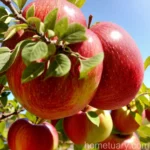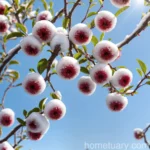The Beauty of Flowering Crabapple (Malus ‘Winter Gold’)
Introduction to Flowering Crabapple
Flowering crabapples, scientifically known as Malus, are beautiful and versatile trees loved by gardeners and horticulturists around the world. One particularly enchanting variety is the Malus ‘Winter Gold’, which is revered for its stunning bloom and ornamental fruit. In this comprehensive guide, we will explore the characteristics of Malus ‘Winter Gold’, its cultivation, and maintenance requirements, as well as its cultural significance and uses.
Key Takeaways of Malus ‘Winter Gold’
Before we delve deeper into the world of Malus ‘Winter Gold’, let’s highlight some key takeaways:
- The Malus ‘Winter Gold’ is characterized by its stunning gold-colored fruit and beautiful blooms.
- Cultivating Malus ‘Winter Gold’ is relatively straightforward, with specific requirements for water, sunlight, fertilizer, soil, and pruning.
- This variety is popular for its ornamental appeal and diverse uses, making it a favored choice for landscaping and aesthetic enhancement.
- Malus ‘Winter Gold’ is resistant to some common diseases and pests, but still requires proper care and maintenance to thrive.
Now, let’s explore the various aspects of Malus ‘Winter Gold’ in more detail.
Culture
The culture of Malus ‘Winter Gold’ encompasses the practices and techniques involved in its cultivation, care, and maintenance. Understanding the cultural requirements is essential for ensuring the healthy growth and development of these captivating trees.
Uses
Malus ‘Winter Gold’ is prized for its versatility and aesthetic appeal, offering a myriad of uses in landscaping and beyond. Here are some common uses of this exquisite crabapple variety:
- Ornamental Purposes: Its beautiful blooms and vibrant fruit make Malus ‘Winter Gold’ a striking ornamental tree, enhancing gardens, parks, and landscapes with its visual allure.
- Wildlife Attraction: The fruit of Malus ‘Winter Gold’ serves as a valuable food source for various wildlife, including birds and small mammals, making it a compelling choice for wildlife gardens and natural habitats.
- Aesthetic Enhancements: Whether used as a standalone specimen or in mixed plantings, Malus ‘Winter Gold’ adds texture, color, and visual interest to outdoor spaces, creating stunning focal points and seasonal displays.
Water
Malus ‘Winter Gold’ thrives in well-drained soil and benefits from regular watering, especially during dry periods and the early stages of growth. Adequate moisture is crucial for supporting healthy foliage, blooming, and fruit production.
Watering Tips:
– Established Trees: Once established, Malus ‘Winter Gold’ typically requires moderate watering, preferably in the early morning or late afternoon to minimize evaporation.
– Young Trees: Newly planted or young trees may need more frequent watering to promote root development and overall vigor.
– Avoid Waterlogging: While Malus ‘Winter Gold appreciates consistent moisture, it is vital to prevent waterlogging, as excessive moisture can lead to root rot and other detrimental conditions.
Sunlight
As with most flowering trees, Malus ‘Winter Gold’ flourishes in full sun exposure, which is defined as at least six hours of direct sunlight per day. Adequate sunlight is essential for robust growth, abundant flowering, and the development of vibrant fruit.
Sunlight Requirements:
– Optimal Positioning: When selecting a planting location for Malus ‘Winter Gold’, prioritize areas with ample sunlight exposure to maximize its ornamental beauty and overall health.
– Consideration for Hot Climates: In regions with particularly hot or intense sunlight, providing some afternoon shade can be beneficial, especially during the peak of summer.
Fertilizer
Proper fertilization is pivotal for sustaining the vigor and vitality of Malus ‘Winter Gold, ensuring it has access to essential nutrients for growth, flowering, and fruit development.
Fertilization Guidelines:
– Balanced Fertilizer: Applying a balanced, slow-release fertilizer in early spring can provide the necessary nutrients for Malus ‘Winter Gold’ throughout the growing season.
– Avoid Excess Nitrogen: While nitrogen is crucial for foliage growth, excessive nitrogen can lead to an imbalance in flowering and fruiting. Select a fertilizer with a balanced NPK ratio suited for flowering trees.
Soil
The soil composition significantly influences the overall health and performance of Malus ‘Winter Gold. Rich, loamy soils with good drainage are particularly favorable for these trees.
Soil Considerations:
– Well-Drained Loam: Malus ‘Winter Gold’ thrives in well-drained loamy soils, which retain moisture without becoming waterlogged.
– pH Levels: Slightly acidic to neutral soil pH (6.0-7.0) is suitable for Malus ‘Winter Gold, promoting nutrient availability and root health.
Pruning
Pruning plays a pivotal role in maintaining the form, structure, and flowering capacity of Malus ‘Winter Gold. Regular pruning and shaping help manage the tree’s size, remove dead or diseased wood, and stimulate new growth.
Pruning Specifics:
– Timing: The ideal time for pruning Malus ‘Winter Gold’ is during late winter or early spring, before the onset of new growth. This is when the tree is dormant and more resilient to pruning.
– Careful Removal: When pruning, focus on removing dead, damaged, or crossing branches, as well as any growth that impedes the tree’s natural form and airflow.
Propagation
Propagating Malus ‘Winter Gold’ allows for the expansion of its presence in gardens and landscapes, as well as the preservation of its unique genetic qualities. Several methods can be employed for propagating these captivating trees.
Propagation Methods
- Seeds: Propagating Malus ‘Winter Gold’ from seeds can be an option, although it may not yield true-to-type offspring, as the genetic variation in crabapples can lead to inconsistent traits in seedlings.
- Grafting: Grafting desirable cultivars onto rootstock is a preferred method for ensuring genetic uniformity and retaining the specific characteristics of Malus ‘Winter Gold’. This approach also expedites the development and maturity of the new trees.
Container Popularity
While Malus ‘Winter Gold’ is typically grown in traditional garden settings, it can also thrive in containers, offering an alternative way to showcase its beauty and enjoy its ornamental attributes in various outdoor spaces.
Container Considerations:
– Selection: Choose a large, sturdy container with adequate drainage holes to accommodate the tree’s root system and support its growth.
– Growing Medium: Utilize a high-quality, well-draining potting mix to provide the necessary support and moisture retention for Malus ‘Winter Gold in a container environment.
Common Diseases
Malus ‘Winter Gold’ exhibits resistance to certain diseases, but it is still susceptible to various fungal, bacterial, and pest-related issues that can impact its health and appearance.
Disease Diagnosis
Common diseases that may affect Malus ‘Winter Gold include:
- Apple Scab: This fungal disease can lead to leaf and fruit damage, causing defoliation and aesthetic deterioration.
- Fire Blight: A bacterial disease that can cause wilting, blackening of blossoms, and dieback of branches, potentially leading to severe damage if left unchecked.
- Cedar Apple Rust: As the name suggests, this disease affects both apples and cedars, leading to distinctive rust-colored lesions on the leaves and fruit.
Disease Management
Implementing proactive measures and maintaining a vigilant approach to disease management are crucial for safeguarding the health and vitality of Malus ‘Winter Gold.
Management Strategies:
– Cultural Practices: Proper sanitation, adequate spacing, and appropriate watering and fertilization can help reduce the likelihood of disease occurrence.
– Fungicidal Treatments: In cases where disease pressure is high, targeted fungicidal applications can aid in preventing and managing fungal diseases.
Common Pests
While Malus ‘Winter Gold’ boasts some resistance to pests, it can still fall victim to certain insect adversaries that pose a threat to its foliage, flowers, and fruit.
Pest Identification
Key pests that may affect Malus ‘Winter Gold include:
- Aphids: These small, sap-sucking insects can cluster on new growth and buds, potentially causing deformities and honeydew secretion.
- Codling Moth: The larvae of codling moths can infest crabapple fruits, leading to internal damage and reduced fruit quality.
- Scale Insects: Scale insects, such as oystershell and armored scales, can adversely impact the health of Malus ‘Winter Gold by feeding on its sap and diminishing its vigor.
Pest Management
Employing effective pest management strategies is essential for preserving the visual appeal and overall health of Malus ‘Winter Gold.
Integrated Pest Management (IPM):
– Monitoring: Regular inspection of the tree for pest activity and signs of infestation enables early intervention and targeted treatments.
– Biological Controls: Beneficial insects and natural predators can aid in controlling pest populations, contributing to a balanced and sustainable approach to pest management.
Botanist’s Tips for Malus ‘Winter Gold’
To cultivate and showcase Malus ‘Winter Gold to its fullest potential, consider the following botanist’s tips:
- Routine Care: Consistent and attentive care, including watering, fertilizing, and pruning, is instrumental in maintaining the health and aesthetics of Malus ‘Winter Gold.
- Disease Monitoring: Regular monitoring for signs of disease and prompt intervention as needed can help protect Malus ‘Winter Gold from potential threats.
- Wildlife Integration: Embracing the wildlife-attracting qualities of Malus ‘Winter Gold can enrich the surrounding ecosystem and contribute to its environmental value.
- Seasonal Observance: Appreciate the seasonal changes and attributes of Malus ‘Winter Gold, from its captivating blooms to its ornamental fruit and fall foliage.
Fun Facts about Malus ‘Winter Gold’
The world of Malus ‘Winter Gold’ is as intriguing as it is captivating. Here are some fascinating fun facts about this enchanting crabapple variety:
- The golden fruit of Malus ‘Winter Gold’ provides a striking contrast against the tree’s dark green foliage, creating a visually stunning display.
- Malus ‘Winter Gold’ is a valuable food source for birds during the winter months, contributing to the ecological balance and biodiversity of its habitat.
- The blossoms of Malus ‘Winter Gold’ are not only visually alluring but also emit a delicate, sweet fragrance, enhancing the sensory experience of encountering these enchanting trees.
Links to External Resources
To further expand your knowledge and appreciation of Malus ‘Winter Gold and flowering crabapples in general, explore the following external resources:
- The Royal Horticultural Society – Crabapple Trees
- University of Minnesota Extension – Growing Apples, Pears, and Cherries in Minnesota Gardens
- Missouri Botanical Garden – Malus ‘Winter Gold’
- Arbor Day Foundation – How to Plant a Tree
In Conclusion
Malus ‘Winter Gold’, with its captivating blooms, vibrant fruit, and ornamental appeal, stands as a testament to the beauty and diversity of flowering crabapples. By understanding its cultivation, uses, care requirements, and significance, we can foster a deeper appreciation for this exceptional tree and its contributions to the natural and horticultural landscapes. Whether adorning gardens, enriching ecosystems, or serving as a source of inspiration, Malus ‘Winter Gold’ continues to enchant and captivate all who encounter its timeless beauty.















